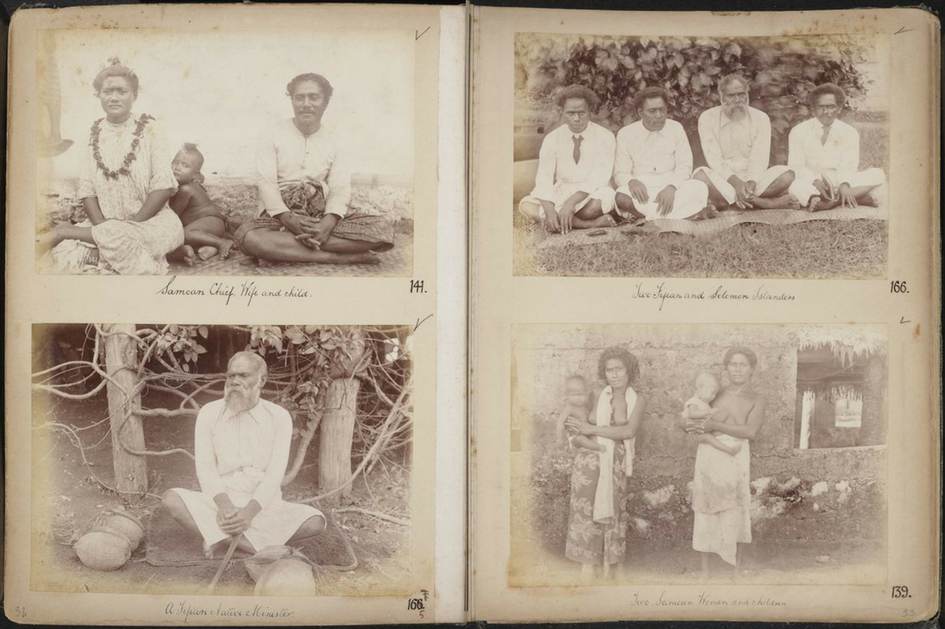We digitise unique materials from our special collections to enhance their discoverability and accessibility, and to preserve 'at risk' items. Access to cultural and historical primary sources through the University's online repository, UQ eSpace, makes them more valuable for use in research, teaching and learning and community engagement.
In this blog post Library staff and artist, Dulcie Stewart presents the result of how communities can make use of digitised collections.
The Veiqia Project
My mixed heritage, Fijian (vasu Banikea, Lekutu, Bua), European and Asian, has influenced my art practice, investigating place, belonging, memory and identity, as well as my role as a family historian.
I am involved in The Veiqia Project, a creative research project inspired by the practice of Fijian female tattooing. The Veiqia Project exhibited at the Fiji Museum earlier this year and at St Paul St Gallery, Auckland University of Technology in 2016 as part of the Auckland Arts Festival.
My installation for the Project, O kemuni mai vei || Where are you from? includes images from the Father Leo Hayes Collection held in UQ Library’s Fryer Library.
Father Edward Leo Hayes
Father Edward Leo Hayes (1889-1969) was a prolific collector and over the course of 70 years, he amassed a great collection of Australiana. The Hayes collection, acquired by Fryer Library through a bequest in 1967, includes three photograph albums of 19th century Fiji, Samoa, Solomon Islands, and Tonga, two of which have been digitised and made available in UQ eSpace.

The images in the albums (H3, H5 and H6) was possibly photographed by Rev. George Brown (1835-1917), a Methodist missionary who produced hundreds of photographs of Pacific people and places between 1876 and 1908.[i]
Photography and social memory
Since 2015, the Project has visited museums, libraries, and archives in Australia, England, Fiji, and New Zealand, investigating traditional Fijian tattooing, a practice that ended between the early 1850s to the 1930s. Fijian girls were tattooed at puberty; the ceremony initiated them as women and signified their eligibility for marriage.
The Veiqia Project exhibitions was a response to the rediscoveries in cultural institutions, but also responses to loss.
O kemuni mai vei || Where are you from? examines the content of archival materials within the context of Fiji’s colonial history and my family history. The work includes framed portraits of Fijian women from the 19th to 21st centuries in a living room setting. The photographs was sourced from my family’s personal collections and those found in cultural institutions and private collections.
Historical documentation of tattooing in Fiji was written from the perspective of non-Fijian authors and does not give us the voice of 19th century Fijian women themselves. My own family history research shows that my male ancestors who settled in Fiji is well documented in archival and published materials, while my Fijian female ancestors, for the most part, remain nameless and faceless.
Photographs of indigenous women have often been understood solely as an expression of the male gaze and much can be said about the gendered and western gaze on the women embodied in historical photographs and the way in which the historical context has been lost. This installation re-imagines the past and re-claims the image making of Fijian women.
The installation invites viewers to consider what it means to look at 19th and 20th century photographs from a different point of view - in an intimate, personal space such as a wall of family portraits.
The historical photographs take on a new meaning when viewed next to my family photographs. In this space, they play an active and integral role in lived experience, knowledge and social memory.
Find out more about Father Edward Leo Hayes through the online exhibition One man's gift: The Father Edward Leo Hayes collection.
Do you use digitised special collections? Please share your story with us by adding your comments to our Facebook or Twitter accounts, using the hashtag #myfryertreasure.
[i] Some copies of the photographs in the albums from Father Leo Hayes collection can be found in other cultural institutional collections. They were identified as been taken by Rev. George Brown. (Brown, George, 1835-1917. (ca. 1890-1905). Rev. George Brown : collection of photographs of Pacific Islands and Islanders (New Guinea, New Britain, Fiji, Solomons, Tonga and Samoa), ca. 1890-1905. PXA 435. State Library of New South Wales; Reverend George Brown Pacific Photographs. Australian Museum, Sydney).